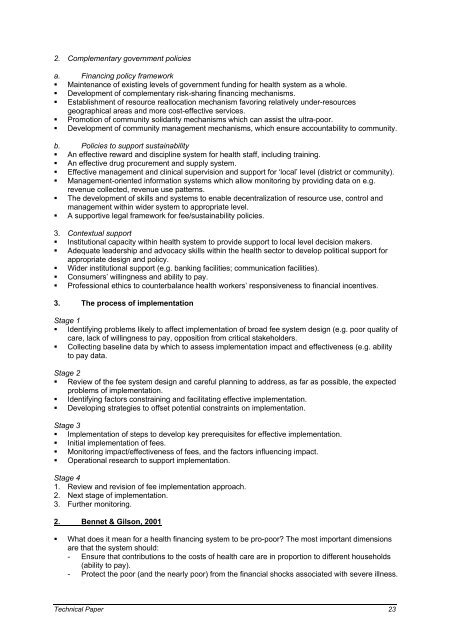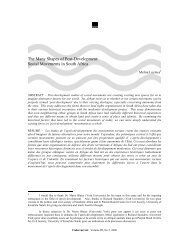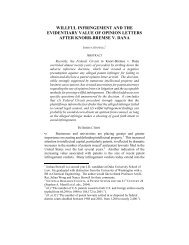equity implications of health sector user fees in tanzania
equity implications of health sector user fees in tanzania
equity implications of health sector user fees in tanzania
Create successful ePaper yourself
Turn your PDF publications into a flip-book with our unique Google optimized e-Paper software.
2. Complementary government policies<br />
a. F<strong>in</strong>anc<strong>in</strong>g policy framework<br />
� Ma<strong>in</strong>tenance <strong>of</strong> exist<strong>in</strong>g levels <strong>of</strong> government fund<strong>in</strong>g for <strong>health</strong> system as a whole.<br />
� Development <strong>of</strong> complementary risk-shar<strong>in</strong>g f<strong>in</strong>anc<strong>in</strong>g mechanisms.<br />
� Establishment <strong>of</strong> resource reallocation mechanism favor<strong>in</strong>g relatively under-resources<br />
geographical areas and more cost-effective services.<br />
� Promotion <strong>of</strong> community solidarity mechanisms which can assist the ultra-poor.<br />
� Development <strong>of</strong> community management mechanisms, which ensure accountability to community.<br />
b. Policies to support susta<strong>in</strong>ability<br />
� An effective reward and discipl<strong>in</strong>e system for <strong>health</strong> staff, <strong>in</strong>clud<strong>in</strong>g tra<strong>in</strong><strong>in</strong>g.<br />
� An effective drug procurement and supply system.<br />
� Effective management and cl<strong>in</strong>ical supervision and support for ‘local’ level (district or community).<br />
� Management-oriented <strong>in</strong>formation systems which allow monitor<strong>in</strong>g by provid<strong>in</strong>g data on e.g.<br />
revenue collected, revenue use patterns.<br />
� The development <strong>of</strong> skills and systems to enable decentralization <strong>of</strong> resource use, control and<br />
management with<strong>in</strong> wider system to appropriate level.<br />
� A supportive legal framework for fee/susta<strong>in</strong>ability policies.<br />
3. Contextual support<br />
� Institutional capacity with<strong>in</strong> <strong>health</strong> system to provide support to local level decision makers.<br />
� Adequate leadership and advocacy skills with<strong>in</strong> the <strong>health</strong> <strong>sector</strong> to develop political support for<br />
appropriate design and policy.<br />
� Wider <strong>in</strong>stitutional support (e.g. bank<strong>in</strong>g facilities; communication facilities).<br />
� Consumers’ will<strong>in</strong>gness and ability to pay.<br />
� Pr<strong>of</strong>essional ethics to counterbalance <strong>health</strong> workers’ responsiveness to f<strong>in</strong>ancial <strong>in</strong>centives.<br />
3. The process <strong>of</strong> implementation<br />
Stage 1<br />
� Identify<strong>in</strong>g problems likely to affect implementation <strong>of</strong> broad fee system design (e.g. poor quality <strong>of</strong><br />
care, lack <strong>of</strong> will<strong>in</strong>gness to pay, opposition from critical stakeholders.<br />
� Collect<strong>in</strong>g basel<strong>in</strong>e data by which to assess implementation impact and effectiveness (e.g. ability<br />
to pay data.<br />
Stage 2<br />
� Review <strong>of</strong> the fee system design and careful plann<strong>in</strong>g to address, as far as possible, the expected<br />
problems <strong>of</strong> implementation.<br />
� Identify<strong>in</strong>g factors constra<strong>in</strong><strong>in</strong>g and facilitat<strong>in</strong>g effective implementation.<br />
� Develop<strong>in</strong>g strategies to <strong>of</strong>fset potential constra<strong>in</strong>ts on implementation.<br />
Stage 3<br />
� Implementation <strong>of</strong> steps to develop key prerequisites for effective implementation.<br />
� Initial implementation <strong>of</strong> <strong>fees</strong>.<br />
� Monitor<strong>in</strong>g impact/effectiveness <strong>of</strong> <strong>fees</strong>, and the factors <strong>in</strong>fluenc<strong>in</strong>g impact.<br />
� Operational research to support implementation.<br />
Stage 4<br />
1. Review and revision <strong>of</strong> fee implementation approach.<br />
2. Next stage <strong>of</strong> implementation.<br />
3. Further monitor<strong>in</strong>g.<br />
2. Bennet & Gilson, 2001<br />
� What does it mean for a <strong>health</strong> f<strong>in</strong>anc<strong>in</strong>g system to be pro-poor? The most important dimensions<br />
are that the system should:<br />
- Ensure that contributions to the costs <strong>of</strong> <strong>health</strong> care are <strong>in</strong> proportion to different households<br />
(ability to pay).<br />
- Protect the poor (and the nearly poor) from the f<strong>in</strong>ancial shocks associated with severe illness.<br />
Technical Paper 23













